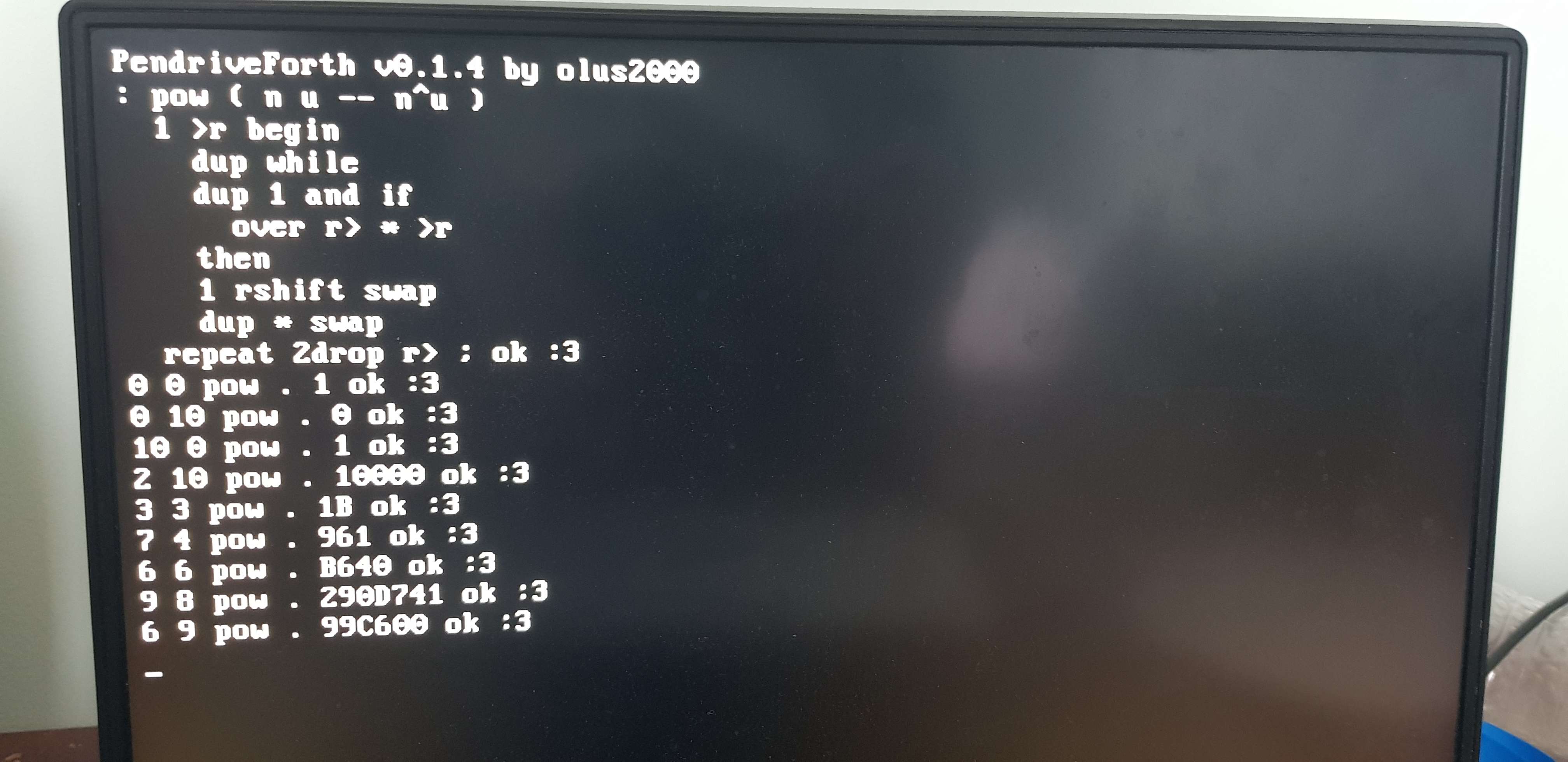A bootable 32-bit Forth system for x86 with(out, yet) a visual block editor. It works in VGA mode 3 with its default codepage 437 charset and 80x25 character display.
DISCLAIMER: This is just a personal beginner project. I make no guarantees about stability or safety of the system. I advise running it in an emulator. Boot it at your own risk.
The recommended way of running PendriveForth is with qemu executable
qemu-system-i386. If you have that and nasm you can run the project
directly by executing make run in the repository folder. If you don't, or
wish to run it differently I hope you know what you're doing because I sure
don't.
The """intended""" way to run PendriveForth is by burning it on a USB stick and
booting directly. My legal team advises me not to recommend this, as I am not
experienced in osdev or assembly and my code may break something on the machine
you boot it from. If you want to try anyway it you should first identify the
disk you want to burn the image into with lsblk or similar tool. Then go
into the repository folder and run:
make cat pdf.img > /dev/your_disk
That should be enough! Now plug the disk into some computer with an x86 processor and try booting from it.
If you're running NixOS, or using Nix on another x86_64-linux system, you can
build the image with the included flake. Make sure you have the nix command and
flakes enabled, then run nix build github:olus2000/PendriveForth to build
image and link the output to ./result.
Unfortunately, due to the way Nix sets permissions on files in the store, the
image will not work with qemu. An easy workaround is to copy the file ignoring
all attributes, cp --no-preserve=all ./result/pdf.img ~/pdf.img.
If you're running Windows or Mac I can't help you, but I'm sure there are tools for your system for compilation, emulation and burning drives.
The source code of this project is entirely contained within the file pendriveforth.asm. It can be split into several parts:
First block of the compiled image is loaded into address 0x7c00 and is responsible for loading the rest of the code and switching to protected mode. It initialises the global descriptor table and interrupt descriptor table, sets up the stacks and executes the initialisation script.
After it jumps to the initialisation script execution is never intended to return to the bootloader and it can be safely overwritten.
The loaded payload starts at 0x500 with the global descriptor table and the interrupt descriptor table.
GDT only has the minimal three entries: the null descriptor, the data descriptor and the code descriptor, the latter two encompassing the entire 32b-addressible memory.
IDT has 48 entries, 32 hardware exception handlers and 16 interrupt request
handlers. Most of them don't actually do anything: exception handlers print an
error message and perform abort, and interrupt requests halt the machine.
The only unmasked interrupt and the only functioning interrupt is interrupt 1:
keyboard. It is responsible for receiving keyboard events, updating pressed
and keys tables and caching the latest keyboard event in last-ekey.
Next follow some pure-assembly subroutines. They are responsible for interfacing with the screen: printing characters and numbers, moving the cursor and scrolling the screen. At some point in the development they will all probably be incorporated into assembly words.
Here actual Forth begins. This section contains the starting section of the
Forth dictionary: definitions of words which bodies are implemented in assembly.
Each word defines two labels: entry_<name> where its dictionary entry
starts, and body_<name> where code of its definition starts. As the project
progresses I will try to keep this section to the minimum implementing as many
words as possible in pure Forth, with a few exceptions for performance. If a
word is defined here then it is in one of the following categories:
- Is required for the print-eval loop
- Requires access to assembly
- Would be very ugly or much slower when written in Forth
For now this section also includes the test label but it here just for the
sake of debugging and will be removed for v1.0
The initialisation script that defines high-level Forth words, including :
and the repl. It consists of a single, long string which is interpreted by the
parse-eval loop after boot.
This repository contains:
- Git/project stuff - LICENSE, README.rst (you are here!) and .gitignore files
- pendriveforth.asm - the source code for the project
- Makefile - the build+run instructions for the unix
maketool - images folder - Where the images in the Gallery reside
- Nix/NixOS flake files - flake.lock and flake.nix
At some point there will be definitions of every word here. Most of them are compatible with the Forth-2012 standard, but some are slightly renamed or have slightly different definitions.

